Outsourcing
IT Vendor Management Best Practices: How to Implement Them Effectively

As businesses become more reliant on technology, they often need specialized solutions and expertise that in-house teams can't fully provide. This requires partnering with external IT vendors for hardware, software, services, and ongoing support.
On average, 35% of IT budgets are spent on external providers. What’s more, some companies may have up to 100 vendors in their ecosystems. Clearly, vendors play a huge role. Yet, optimal vendor management continues to pose a challenge for many. This is attributed to the intricate journey that characterizes vendor management— a journey comprised of distinctly featured stages:
- Vendor selection
- Vendor management
- Vendor performance monitoring
After an in-depth exploration of IT vendor selection in our previous piece, the spotlight now shifts to IT vendor management – involving critical aspects of collaboration that influence future vendor partnerships.
In the upcoming sections, we will unravel IT vendor management best practices for managing and scaling vendor relationships to enhance their value and curtail associated risks. Guided by some practical tips and steps, your organization will be better equipped to cultivate partnerships that propel long-term success.
What IT vendor management best practices actually involve
Vendor management isn't just about making purchases, it's about artfully crafting a strategy that goes beyond transactions, focusing on building a mutually beneficial relationship with vendors. It starts with gaining full visibility into your vendors and contracts.
The result? This allows both parties to identify opportunities to optimize investments, reduce risk, and drive innovation. In addition, you strengthen supply chain resilience, accelerate results, and maximize value. Your vendors become real partners in driving business performance. Either it's a first-time trial or building an IT project transition plan, vendor management is an important step for your business success.
Key to this is a well-planned strategy, constant checking of performance, and always looking for ways to improve. At the core of vendor management are vital components:
- Contract management
- Vendor onboarding:
- And relationship management
In addition, effective vendor management should also consider:
- Monitoring and controlling risks with each vendor (including, but not limited to, data security, service delivery, or legal compliance).
- Vendor consolidation in instances when a company manages multiple vendors.
In sum, it looks like vendor management is like a busy intersection where cost-effectiveness, high quality, reduced risk, and excellent service come together. The goal is to nurture a mutually beneficial relationship with vendors, to ensure smooth operations and project success.
Why relationships with IT vendors are so important
Many vendor relationships may often seem fine on the surface and often disguise inefficiencies, poor performance, and potential compliance gaps. Without proper oversight and governance, vendors may take advantage of the situation.
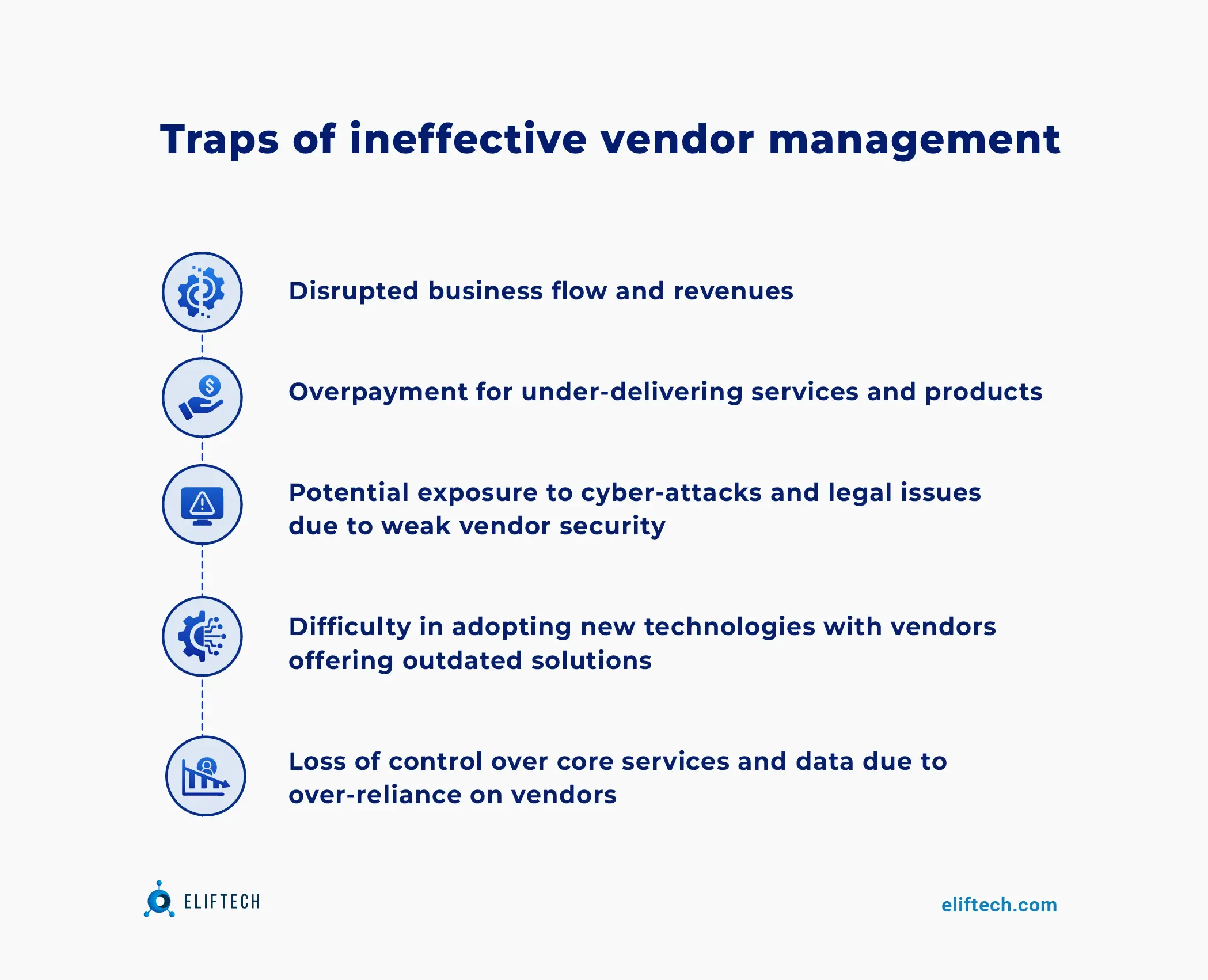
There are some potential traps of ineffective vendor management:
- Above all, ineffective vendor management can seriously impact operations and the bottom line.
- It also causes organizations to overpay for underwhelming solutions like software lacking important features.
- If a company does not thoroughly vet a vendor's security measures, it may expose sensitive data to cyber attacks, potentially leading to legal problems.
- Moreover, it can hinder the adoption of new technologies. Suppose a company is tied to a vendor offering outdated technology due to long-term contracts.
- Ultimately, you lose control over critical services, systems, and data.
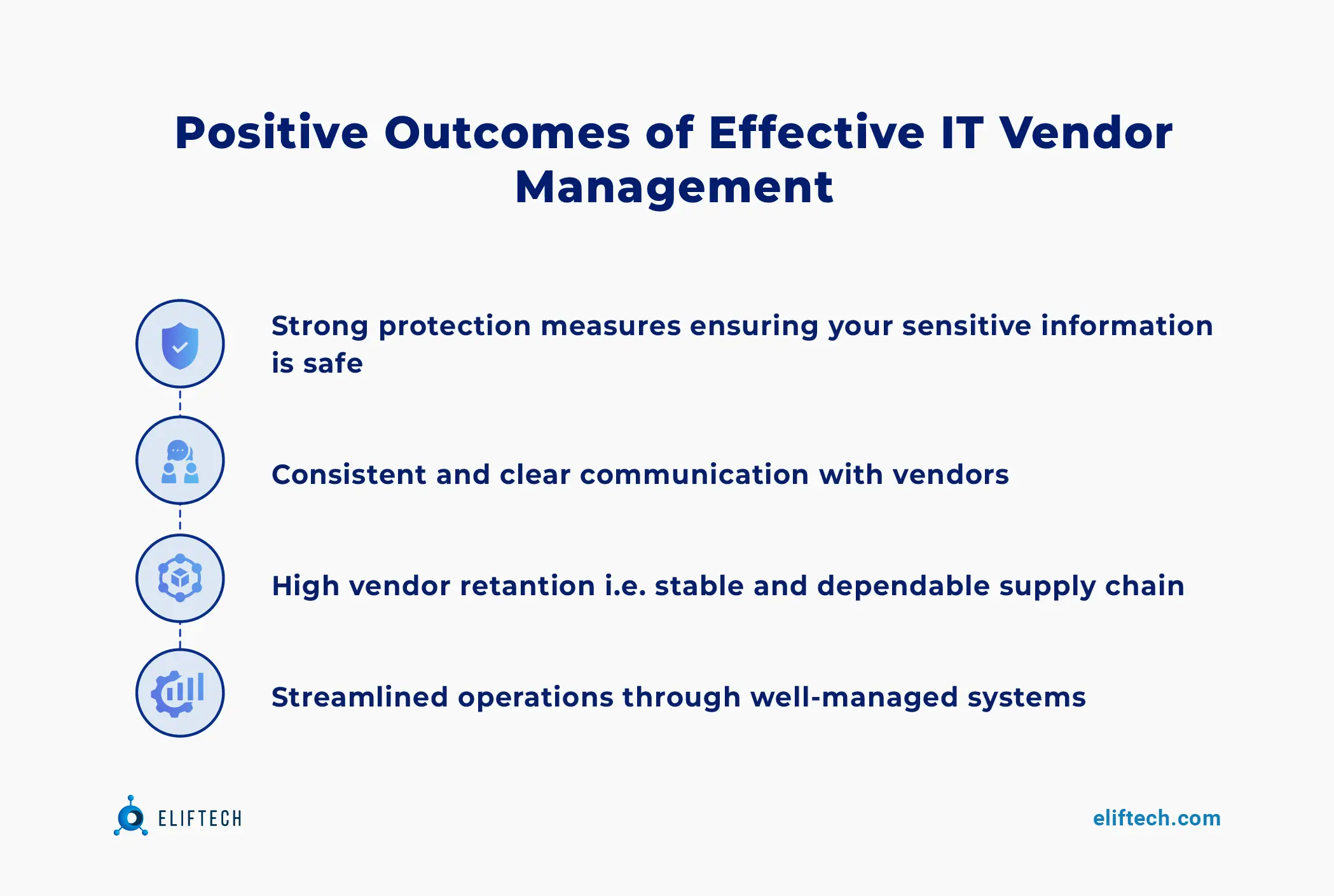
The good news is that improving vendor management is very achievable. By establishing clear SLAs, regular performance reviews, and proactive communications, you can align vendors with your strategic goals. Some of the positive outcomes include:
- Robust data protection, sound emergency plans, and regular assessments of deliverables ensure project objectives remain on track.
- Well-managed vendor relationships that lead to improved negotiations, meticulous performance monitoring, and swift dispute resolution – it's essentially a cost-saving toolkit.
- Higher vendor retention thanks to enhanced communication, transparent contracts, and consistent performance reviews – resulting in a decrease in turnover and a more dependable supply chain.
- Process optimization achieves the perfect balance of efficiency by employing vendor management systems, aligning vendor expectations, and promoting feedback, thereby streamlining operations and enhancing service quality.
What is not written on a paper
Just giving the vendors their marching orders doesn't quite cut it anymore in a modern business landscape. The goal is to establish shared goals, insights, stability, and even reputation. Why? Because in an increasingly outsourced, global, and lean business universe, being a vendor means more than just delivering tasks.
From our perspective, understanding and aligning with our clients' visions accounts for 50% of success. In our portfolio, we have cases where we've worked with certain clients for years, growing together and elevating both our reputation and market position. In practice, we believe that integrating ourselves as an inseparable part of our client's teams and acting as allies in their journey to success provide greater benefits compared to simply being external service providers.
Everything starts with a contract
When dealing with vendor management, we have to start at the very base: the contract. While a firm handshake and a shared vision play their part, having a detailed contract is what seals the deal. Think of it as a blueprint – a well-defined plan highlighting responsibilities, expectations, and guiding principles.
Now you might wonder, "What goes into making this contract an effective one?"
- Firstly, Contract Negotiation. And it isn't a race to the bottom for the cheapest option, but rather a move to find a win-win compromise that delivers value. A quality project management for application development means finding what works best for the business, its customers, and project success.
- Secondly, you need Interdepartmental Collaboration. All teams involved need to be on board, understanding their responsibilities and expectations, and building a comprehensive contract devoid of discrepancies.
- Finally, consider Contract Adaptability. Your contracts need to mirror dynamism to avoid outdated technologies or practices.
The importance of a contract might seem self-evident, yet it's astonishing how many people undermine its significance. An effective contract stands as a sturdy bridge between you and your vendor – it fosters consistency and predictability. Establishing this strong groundwork enables trust and a fruitful relationship to flourish. This isn't solely about engaging a vendor but about inviting them to embark on a journey – a shared vision driving towards success.
An articulate contract rallies everyone involved – it stipulates the terms, deals, and performance expectations. It distinguishes what’s acceptable, and what’s not, and the consequences fall south of expectations. It outlines the boundaries, and the potential stumbling blocks—essentially crafting a comprehensive view of what the partnership entails.
Why vendor onboarding is a crucial stage
Welcoming an IT vendor into your company's ecosystem involves a convergence of technology, business objectives, data security, and compliance requirements. It's like welcoming a new team player; you've chosen them carefully and now it's time to integrate them into your team with a well-crafted strategy — the first step to embark on a successful partnership.
This effective partnership would need a robust, personalized onboarding process which can be boiled down to the 'Big Six' steps:
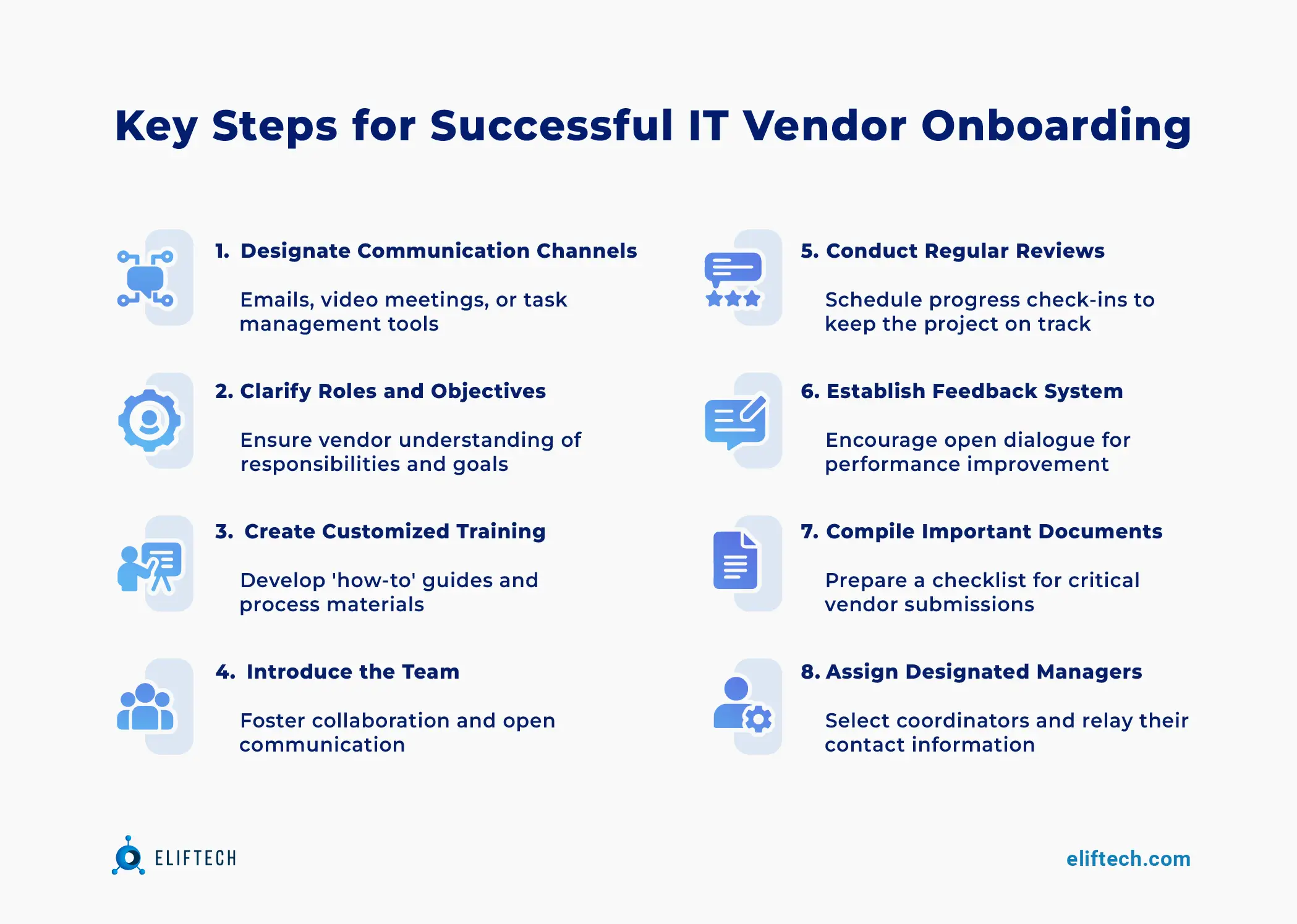
- Defined communication channels: Establishing clear and direct communication paths (be it emails, video meetings, or task management tools) provides the foundation for a responsive and transparent relationship.
- Clear roles and objectives: Ensure that your vendor understands their role and what they're expected to accomplish (their objectives) as part of the bigger picture. This roadmap acts as a compass for the vendor, steering the project in the right direction.
- Customized training: Prepare a set of training materials – 'how-to' guides, introductory videos, and process documents – which give a detailed overview of your business, systems, and standard operating procedures. Organize training sessions via virtual meetings or webinars for the vendor's key personnel.
- Introducing the team: It's important for your vendor to know who they will be working with. This fosters collaboration, builds a healthy working environment, and facilitates an open line of communication.
- Regular progress check-ins: Just like the pulse checks in a patient, have scheduled reviews to monitor the health of the project, identify bottlenecks, and recalibrate strategies timely. This ensures the project remains on track.
- Constructive feedback system: Incorporate a mechanism that encourages open dialogue for performance reviews. This process promotes growth and refines the relationship, keeping it beneficial to both parties. Make sure to negotiate the need for any support and maintenance services at this stage.
In addition to these preparatory and procedural steps, getting the paperwork in order is crucial.
- Prepare a checklist for critical documents you'll need from the vendor, such as tax forms, licenses, and insurance certificates. Make sure you have all the fiscal arrangements — payment terms, invoicing, etc. — set correctly and transparently.
- Assign designated managers from your organization who'll be responsible for coordinating with the vendor. Relay this information to all impacted teams so they know whom to reach out to with issues or queries related to the vendor.
Moreover, understanding your IT vendor's work culture, obtaining an insight into their working style, and customizing the onboarding process accordingly can immensely enhance the effectiveness of your partnership. This approach, which utilizes data-backed feedback to continually refine the process, creates an optimized, streamlined, and result-oriented collaboration.
IT vendor performance management
Evaluating your IT vendor's performance is an essential ongoing process that ensures the collaboration stays efficient, compliant, and result-oriented. It includes identifying clear parameters for success, setting the bar for performance, employing tracking mechanisms, and creating feedback loops.
A well-calibrated performance management system in place brings to life a dynamic, reciprocal relationship with the vendor that thrives on transparency, mutual growth, and a steady pursuit of shared objectives. If you haven't developed it yet, you can sculpt an effective performance management strategy with several points in mind:
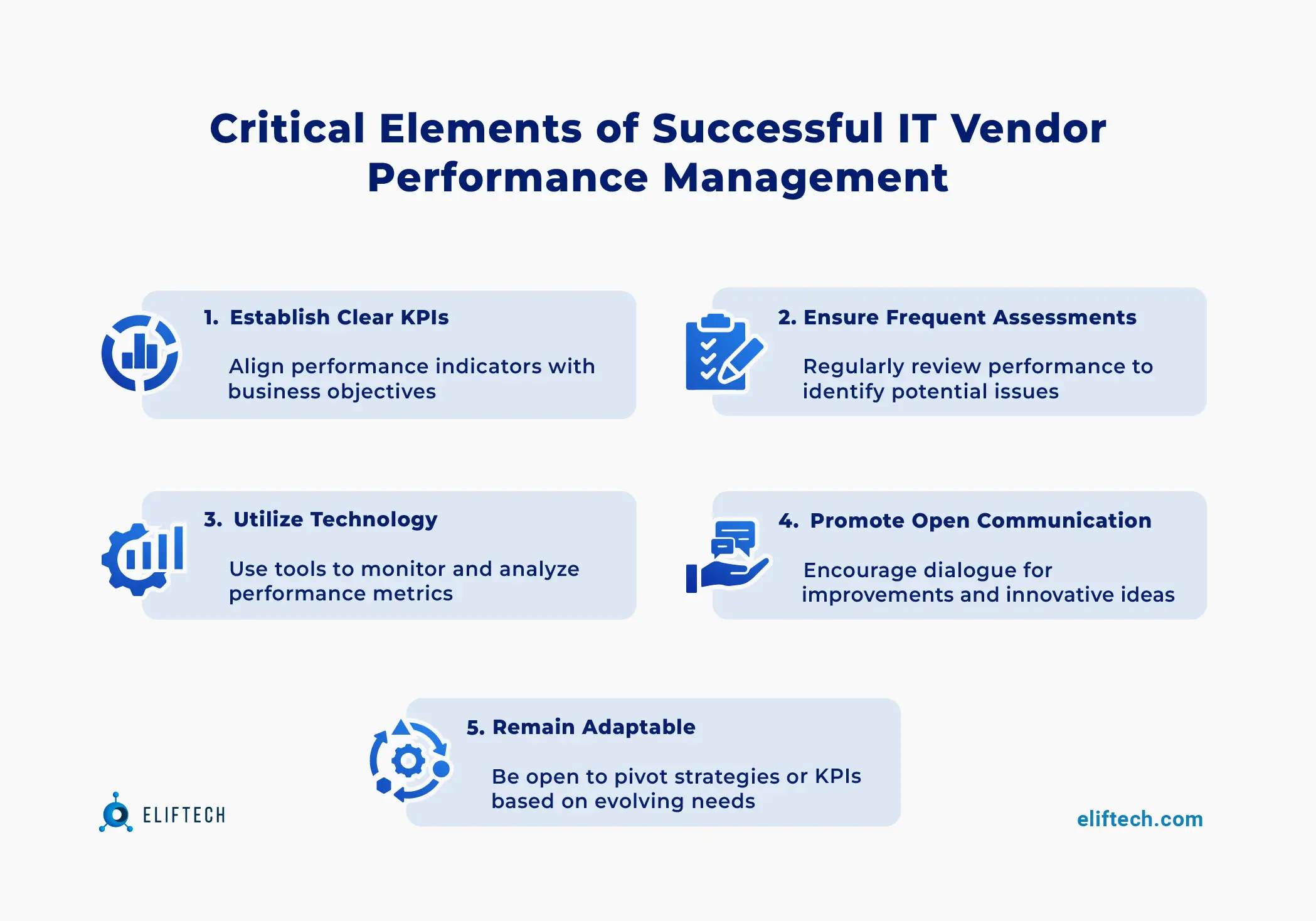
1. Embrace the power of KPIs
Establish concrete Key Performance Indicators (KPIs). Align these KPIs with your business vision; they serve as your compass, helping steer your vendor's efforts toward your targeted objectives. For instance, if your business is focused on improving customer service, an appropriate KPI might be "Vendor Response Time". This provides a clear indication of how efficiently your vendor is handling customer inquiries.
2. Regularity is the key
The term "Set it and forget it" doesn’t apply here. Stay engaged and carry out frequent performance assessments. This proactive approach aids in identifying any speed bumps early and allows you to course-correct timely. Regular performance assessments could look like monthly scorecard reviews. Through assessing monthly report cards, you can gauge if targets are being met and respond swiftly to discrepancies.
3. Leverage technology
The use of performance management tools can systematize evaluation processes by tracking service tickets, monitoring response times, and analyzing quality metrics. With these detailed and real-time insights, your team is better equipped to make data-driven decisions, enhancing both vendor performance and customer satisfaction. For example, noticing a repetitive issue in monthly reports can lead to the deployment of targeted training for vendor staff, reducing the occurrence of the issue in subsequent months.
4. Open communication channels
Maintain a culture where honest dialogue is encouraged—this can help in troubleshooting, fostering improvements, and generating innovative ideas. The vendor’s perspective can often provide a novel approach that may prove beneficial. Bi-weekly virtual meetings can be a perfect example of maintaining open communication. These sessions allow feedback to be shared freely to reveal potential challenges and discuss innovative solutions.
5. Stay fluid, embrace change
Performance optimization is not static; it demands constant tuning and adaptability. Take the lessons learned from your journey, fine-tune your approach, and don't be afraid to try new strategies in your performance management playbook. If a particular KPI isn't yielding the expected results, don't hesitate to swap it out for another that might better align with your current needs. The ability to pivot is often the key to maintaining peak performance.
Vendor risk management
Certainly, in any collaboration, risks are par for the course, and IT vendor management is no exception. As we build these vital partnerships, we must consider how to predict and circumnavigate potential challenges that may arise. Such risks can emerge from a myriad of sources, like data breaches, regulatory non-compliance, unsatisfactory service performance, or even an over-dependence on a single vendor.
To tackle these issues, here are some thoughtful strategies for your risk management game:
- Incorporating risk mitigation clauses: For instance, adding a clause in the contract specifying that the vendor will bear the cost of a data breach can help lessen financial impacts if such an unfortunate event occurs. It's akin to having a protective shield; while it may not prevent every scratch, it significantly lessens any lasting damage.
- Diversifying your vendors: Spread your bets wisely by not relying solely on one vendor. For example, instead of using a single vendor for your IT needs, you might have one vendor for software requirements and another for hardware. That way, if one vendor encounters a problem, the other can still deliver adequately.
- Regularly monitoring performance: Suppose a vendor constantly misses deadlines, this could be a warning sign of potential future problems. Regular performance monitoring would highlight this issue early, allowing you to address it before it has a significant operation impact.
- Creating a comprehensive risk management plan: This entails having a game plan on handling potential risks, identifying who takes the reins during turbulent times, and ensuring transparent communication throughout the process. In case of a data breach, a risk management plan could dictate that your IT security team takes charge, notifies relevant stakeholders, and collaborates with the vendor to patch vulnerabilities and prevent future breaches.
But let's not forget, risk management is an ongoing venture. It calls for adjustment and continuous improvement, so your organization stays ahead of potential challenges and keeps the momentum going.
What if there are multiple vendors?
As businesses expand their IT infrastructure, they might end up partnering with multiple IT vendors offering similar services. As we mentioned, some companies have up to 100 vendors in their ecosystems.
The immediate benefits are evident. Streamlined vendor management, reduced administration overhead, enhanced negotiation power, and, crucially, the ability to focus on forming robust strategic partnerships.
However, there's a caveat. Consolidation doesn't imply haphazardly reducing vendor numbers. It's about strategic balancing – avoiding over-dependence on a single vendor while still optimizing the vendor mix. Vendor consolidation is essentially like spring cleaning – eliminating the unnecessary clutter, making space, and thereby better appreciating and managing what's essential.
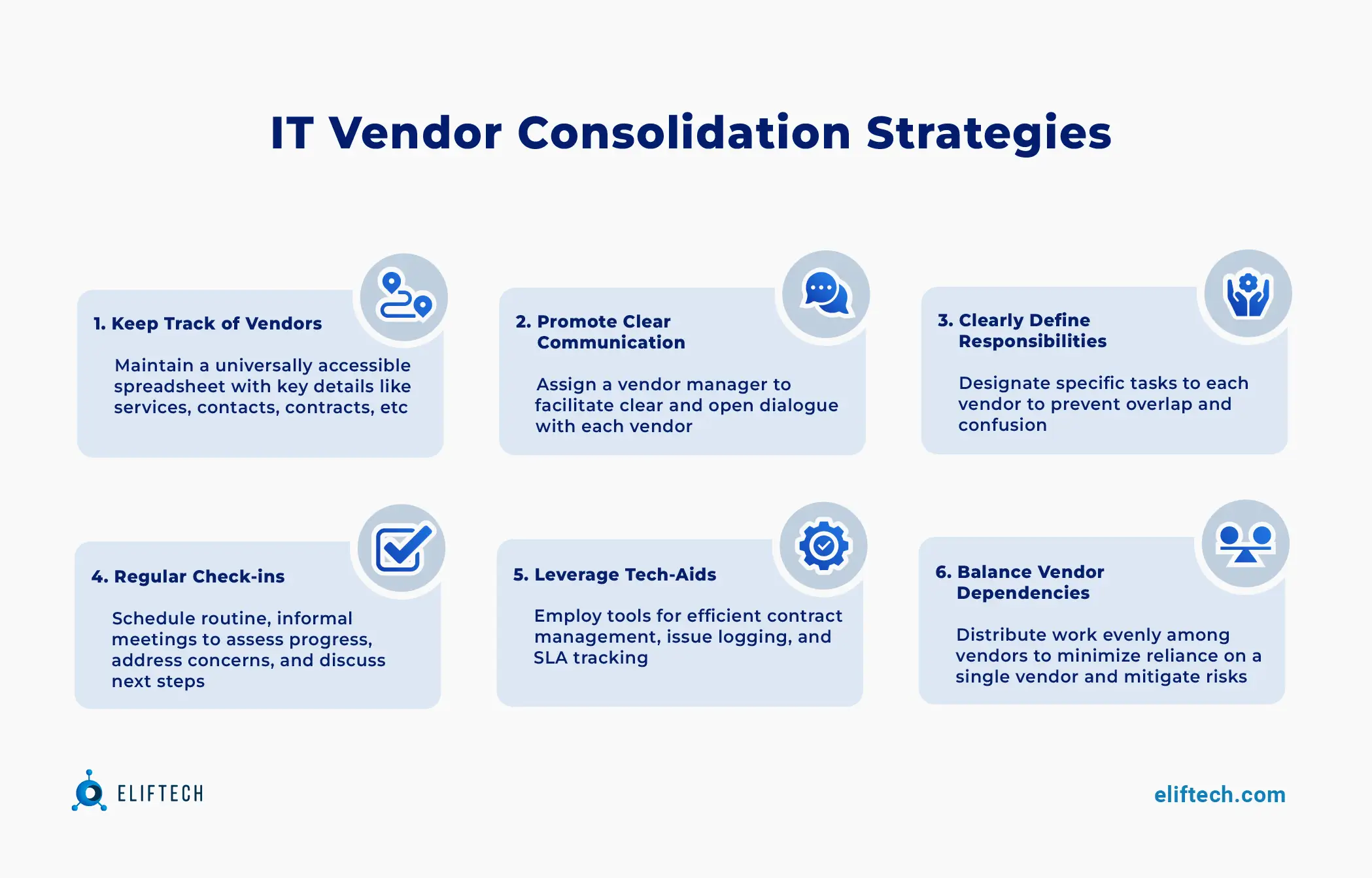
Here are some practical tips to keep a piece in your IT vendor family:
- Keep an eye on them: For instance, maintain a cloud-based spreadsheet with all key vendor information – like services provided, key contacts, and contract end dates. This live document can be accessed and updated by anyone in real time, keeping everyone on the same page.
- Foster clear communication: Appointing a liaison, such as a vendor manager who works as the main point of contact for every vendor, ensures all communication lines are clear and open. They will be responsible for gathering and disseminating information to and from the vendors.
- Clear-cut duties: Make sure each vendor knows their assigned tasks like the back of their hand. For instance, if you have multiple software vendors, clearly designate which vendor is responsible for which software development or maintenance task. This ensures each vendor knows their responsibilities and there is no confusion or overlap.
- Regular performance 'Coffee Chat': Organize routine casual catch-ups (maybe over coffee) with each vendor to assess how they're moving along, remind them of upcoming milestones, and chat about any challenges.
- Leverage tech aids: Use a tool like ServiceNow for managing vendor contracts, logging issues, and tracking SLAs. This not only optimizes vendor management but also ensures you're not losing track of important information amongst multiple vendors.
- Maintain a vendor see-saw: Relying too much on one vendor can be risky business. Keep your power scale balanced among vendors, giving you a solid standing ground. If you have three marketing vendors, rather than having one vendor handle 75% of the work and the other two only picking up 12.5% each, allocating the work distribution more evenly helps to balance dependencies and mitigate risk if one vendor underperforms.
Conclusion
Effective implementation of IT vendor management best practices brings cost optimization, security, and aligned delivery. It enables you to find the right vendors, negotiate better terms, and manage performance. The returns easily justify the effort.
In the middle of all the vendor selection, relationship management, and performance check-ins, don't forget to cultivate strong lines of communication, ensure regular check-ups, and keep encouraging improvements. These aspects are the linchpin of fruitful, long-term associations.
Speaking as a vendor, we take pride in long-standing software development partnerships with our clients, working as allies through our shared journeys. We're honored to be part of our clients' journeys, working together as one team to success. With an emphasis on personalized solutions, we're driven to meet your company's unique needs, whether you're a small player or a big fish in any industry. Our capabilities in areas such as cloud computing, AI, big data, and more, position us to tackle complex business demands effectively.
We're super proud to hold good reviews on Clutch and to have landed ourselves amongst the top 10% of Clutch Global Winners in 2023. In our work, we believe in being way more than just vendors – we're your tech partners, your team members, and your companion in achieving bigger dreams. Why? Because it's about more than technology. It's about people, relationships, and shared visions. That's what we're all about.
